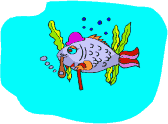 |
Fishing Stories from Ned Kehde |
|
Fishing Reports Reader's Nook Angler's Academy Club Corner Tournament Trail Success Stories Kansas Angler Info Angler Links |
Click here for Zeiners new secure online catalog Rogue is catching bass Submitted by Ned Kehde - April 15, 2002 March is Rogue season in these parts. That doesn't mean that a bunch of scamps and scoundrels are on the loose. But it does mean that a Smithwick Lures' Rogue is often wrecking havoc with the largemouth and smallmouth bass that abide in several of the lakes hereabouts. In the vernacular of wintertime bass fishermen, a Rogue is a twitchbait, meaning that it is slowly retrieved with subtle, enticing twitches. To accomplish this retrieve, an angler wields a medium-action baitcasting outfit that is spooled with either eight or 10-pound test line. The size of line is determined by the water clarity. When the water is gin-clear, most anglers opt for eight-pound line. Eight-pound line also gets the Rouge a few feet deeper than the 10-pound line, and depth can be a significant factor at times. To the line, a 4 12-inch Suspending Rattlin' Rogue is affixed. Often some weight has to be added to the Rogue to make it neutrally buoyant. This is accomplished by adding one or more Storm SuspenDots in front of the first hook. And when the water temperature is 42 degrees and colder, some anglers have found that a slowly sinking Rogue will inveigle more bass than a neutrally buoyant one. To get the Rogue to slowly sink, another SuspenDot is placed on the Rogue. History has shown that the most enticing Rogue in the eyes of the bass in northeastern Kansas is the clown-colored one. But such color combinations as black-silver-orange, blue-silver-white, and black-gold-orange regularly beguile a lot of cold-water bass. Some Lawrence anglers, such as Tom Fritschen, Steve Ortiz, Alan Geiss and Bob Laskey, begin plying the small, clear community lakes as soon as the ice melts in February. On a few of these outings the water was so cold that small shards of ice gathered along the windward banks, and as the waves push these shards against a rocky shorelines, the shards chimed, making it sound as if there were wind chimes hanging in the trees. In winters past these anglers have been able to entice a dozen or more largemouth bass on outings as early as Valentine's Day, but not this winter. Even though it has been as unseasonably warm winter, bass anglers note that several severe but short-lived cold fronts, such as the ones that hit on Feb 25 and Mar 2, have periodically buffeted northeastern Kansas. And the timing of these fronts kept the water too cold and bass too discombobulated and sullen for bountiful fishing. When the water temperature hovers around 40 degrees and the bass become persnickety, anglers have to use an excruciatingly slow retrieve. To do this, an angler makes a long cast, allowing the Rogue to land about five feet from the shoreline. Then the angler points the rod tip at the water and makes four quick revolutions of the reel handle, pulling the Rogue about four feet under the surface. Next the Rogue is allowed to suspend or slowly fall towards the bottom for 10 seconds. After that 10-second pause, the angler delicately twitches the rod once by flexing his wrist and then slowly reels up the slack line. This twitch and 10-second pause continues until Rogue is retrieved back to the boat. Once the water temperature broaches 43 degrees, as it did on Feb 23, the pause can be shorten to six seconds or less. Using a five-second pause on Feb. 23, Steve Ortiz caught and released 15 nice-sized bass at Lone Star Lake in five hours and Tom Fritschen tangled with 60 small ones at Leavenworth State Fishing Lake during a two-hour outing. When the water temperature reaches the high 40s, the pause is seldom longer than three seconds, and anglers often employ a double or triple twitch. Fritschen and Ortiz predict that the Rogue fishing will continue until the water temperature surpasses 52 degrees in early April. What's more, the traditional March winds, which some fishermen cuss, seem to enhance the Rogue's allure in the eyes of the eastern Kansas' largemouth and smallmouth bass, and perhaps that's why March is Rogue time in these parts. |
||
|
Kansas Angler Online Sponsor  |
Copyright 1999-2002 by The Kansas Angler - Phone 316-265-5551 Questions or problems with this website should be directed the link above. This Page Last Updated on date shown at top of page. |
